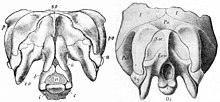The proatlas is a paired bone in the skeleton of many vertebrates that occurs between the skull and the first cervical vertebra. It ossifies endochondrally.

A number of different interpretations have been made of the proatlas. The most common interpretation is that it is the vestigial neural arch of a vertebra that is otherwise fully incorporated into their skull, but the development shows some differences from other vertebrae that present difficulties for this hypothesis.
The proatlas was probably widely present across early tetrapods, and is retained in some modern reptiles, such as the tuatara. In crocodylians, the left and right proatlases fuse into a single V-shaped midline element.
A proatlas can occur pathologically in humans.
The proatlas was first recognized in dinosaurs by Othniel Marsh, who initially termed them the "post-occipital bones", but their homology with the proatlas of other reptiles was subsequently recognized by Charles W. Gilmore.
References
- ^ Korneisel, Dana E.; Vice, Rebekah; Maddin, Hillary C. (2021-11-30). "Anatomy and development of skull–neck boundary structures in the skeleton of the extant crocodylian Alligator mississippiensis". The Anatomical Record. 305 (10). doi:10.1002/ar.24834. eISSN 1932-8494. ISSN 1932-8486.
- Baur, G. (1886). "The proatlas, atlas and axis of the Crocodilia". The American Naturalist. 20 (3): 288–293. doi:10.1086/274205. ISSN 0003-0147.
- ^ Mook, Charles C. (1921). "Notes on the postcranial skeleton in the Crocodilia". Bulletin of the American Museum of Natural History. 44: 67–100.
- Romer, Alfred Sherwood (1956). Osteology of the Reptiles.
- Muhleman, Mitchel; Charran, Ordessia; Matusz, Petru; Shoja, Mohammadali M.; Tubbs, R. Shane; Loukas, Marios (2012). "The proatlas: a comprehensive review with clinical implications". Child's Nervous System. 28 (3): 349–356. doi:10.1007/s00381-012-1698-8. eISSN 1433-0350. ISSN 0256-7040.
- Marsh, O. C. (1883). "Principal characters of American Jurassic dinosaurs. Part VI: restoration of Brontosaurus" (PDF). American Journal of Science. 3. 26 (152): 81–85. doi:10.2475/ajs.s3-26.152.81. ISSN 0002-9599.
- Gilmore, Charles W. (1907). "The type of the Jurassic reptile Morosaurus agilis redescribed, with a note on Camptosaurus". Proceedings of the United States National Museum. 32 (1519): 151–165. doi:10.5479/si.00963801.32-1519.151. ISSN 0096-3801.
| Bones in the tetrapod skeleton | |||||||||||||||||||||||||||||||||||||||||||||
|---|---|---|---|---|---|---|---|---|---|---|---|---|---|---|---|---|---|---|---|---|---|---|---|---|---|---|---|---|---|---|---|---|---|---|---|---|---|---|---|---|---|---|---|---|---|
| |||||||||||||||||||||||||||||||||||||||||||||
| |||||||||||||||||||||||||||||||||||||||||||||
| |||||||||||||||||||||||||||||||||||||||||||||